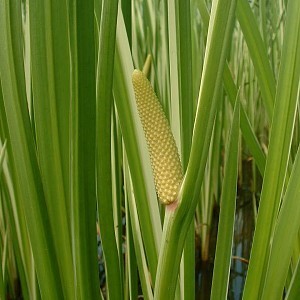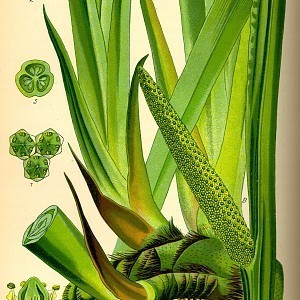Acorus Calamus
#
General Description #
- Common Names – Synonyms
- In addition to “sweet flag” and “calamus” other common names include beewort, bitter pepper root, calamus root, flag root, gladdon, myrtle flag, myrtle grass, myrtle root, myrtle sedge, pine root, rat root, sea sedge, sweet cane, sweet cinnamon, sweet grass, sweet myrtle, sweet root, sweet rush, and sweet sedge.[2] Common names in Asia include: “Changpu 菖蒲” (Mandarin Chinese); “shoubu 菖蒲” (Japanese); “vacha”; “changpo 창포” (Korean); “bacch” (Unani); “bajai”, “gora-bach”, “vasa bach” (Hindi); “vekhand” (Marathi); “vasambu”/வசம்பு (Tamil); “vadaja”, “vasa” (Telugu); “baje” (Kannada); “vayambu” (Malayalam); Haimavati, “bhutanashini”, “jatila” (Sanskrit), “kâmpean” កំពាន (Khmer) and “bojho बोझो” (Nepali).
- Order
- Acorales
- Genus
- Aciotis
- Family
- Acanthaceae
- Origin – Distribution
-
- Africa
- Level of Difficulty
- Beginner / Easy
- Height
- 20-30cm (7.9-11.8 Inches) High
- Width
- 30-40cm (11.8-15.7 Inches) Wide
- Growth Rate
- Slow
- Light Requirements
- Medium Light (35-50 PAR)
- Co2 Requirements
- Yes (High light) (30+PPM)
- Plant Type
- Bulbous / Bulb
- Carbonate Hardness (dKH)
- 4
- Can Be Grown Emmersed?
- Yes
The solid, triangular flower-stems rise from the axils of the outer leaves. A semi-erect spadix emerges from one side of the flower stem. The spadix is solid, cylindrical, tapers at each end, and is 5 to 10 cm in length. A covering spathe, as is usual with Acoraceae, is absent. The spadix is densely crowded with tiny greenish-yellow flowers arranged in diamond-shaped pattern. Each flower contains six petals and stamens enclosed in a perianth with six divisions and surrounding a three-celled, oblong ovary with a sessile stigma. The flowers are sweetly fragrant. In Europe it flowers for about a month in late spring or early summer, but usually does not bear fruit there. Only plants that grow in water bear flowers. The fruit is a berry filled with mucus, which when ripe falls into the water and thus disperses. Even in Asia it fruits sparingly and propagates itself mainly by spreading its rhizome, forming colonies.
The branched, cylindrical, knobby rhizome is about a finger thick and has numerous coarse fibrous roots below it. The exterior is brown and the interior white.
Distribution #
DISTRIBUTION MAP WILL GO HERE…
Cultivation #
References #
According to Thompson the primary morphological distinction between the triploid and the North American forms of the diploid is made by the number of prominent leaf veins, the diploid having a single prominent midvein and on both sides of this equally raised secondary veins, the triploid having a single prominent midvein with the secondary veins barely distinct. Thompson notes a number of other details which she claims can be used to tell the different forms apart in North America, such as flower length, average maximum leaf length, relative length of the sympodial leaf with respect to the vegetative leaves, the average length of the spadix during flowering, and tendency of the leaf margin to undulate in the triploid. She notes that many of these characteristics overlap, but that in general the triploid is somewhat larger and more robust on average than most North American forms of the diploid. According to Heng Li, Guanghua Zhu and Josef Bogner in the Flora of China there is clear overlap in these characteristics and the different cytotypes are impossible to distinguish morphologically.
Triploid plants are infertile and show an abortive ovary with a shrivelled appearance. This form will never form fruit (let alone seeds) and can only spread asexually.
The tetraploid variety is usually known as Acorus calamus var. angustatus Besser. A number of synonyms are known, but a number are contested as to which variety they belong. It is morphologically diverse, with some forms having very broad and some narrow leaves. It is furthermore also cytotypically diverse, with an array of different karyotypes.
Miscellaneous Information & Links #
The generic name is the Latin word acorus, which is derived from the Greek άχόρου (áchórou) of Dioscorides (note different versions of the text have different spellings). The word άχόρου itself is thought to have been derived from the word κόρη (kóri), which means pupil (of an eye), because of the juice from the root of the plant being used as a remedy in diseases of the eye (‘darkening of the pupil’).
The specific name calamus (meaning “cane”) is derived from Greek κάλαμος (kálamos, meaning “reed”), which is cognate to Latin culmus (meaning “stalk”) and Old English healm (meaning “straw”), and derived from Proto-Indo European *kole-mo- (thought to mean “grass” or “reed”). The Arabic word قَلَم (qálam, meaning “pen”) and Sanskrit कलम (kaláma, meaning “reed used as a pen”, and a sort of rice) are thought to have been borrowed from Greek.
The name sweet flag refers to its sweet scent and its similarity to Iris species, which are commonly known as flags in English since the late fourteenth century.
Additional Links:
Wikipedia





